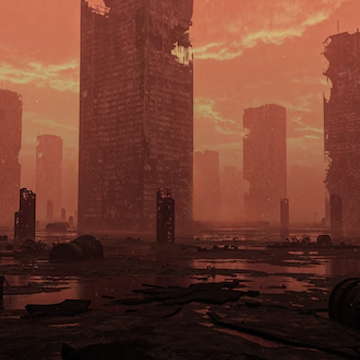
Worldbuilding Workshop: Creating Earth 0’s Ruined Cityscape
- admin
- June 3, 2025
Table of Contents
When crafting a dystopian story, the world itself often becomes a character—one that shapes the narrative, mood, and emotional stakes for readers. In The Assassin Falls by June Steed, Earth 0’s crumbling cityscape isn’t just a backdrop; it’s a vivid, immersive environment that tells its own story of decay, control, and despair.
Today, I’m pulling back the curtain on how the ruined city of Earth 0 was created—breaking down the details that matter, the atmosphere they evoke, and why a carefully constructed environment can elevate a story from good to unforgettable.
Why Worldbuilding Matters: Setting the Stage for a Story
A ruined city isn’t just about broken buildings or empty streets—it’s a reflection of the world’s history, its politics, and its fears. The environment influences the characters’ choices and emotions. It sets the mood and builds tension before a single word of dialogue is spoken.
In The Assassin Falls, Earth 0’s city is a desolate shell, a haunting monument to a society that traded freedom for order—and lost both in the process. To build such a setting, every detail must feel deliberate and meaningful, shaping the reader’s experience and immersing them fully in this dystopian nightmare.
Building Earth 0: The Key Elements of Decay
Visual Decay and Structural Collapse
The first thing readers notice about Earth 0 is its ruined skyline—towering buildings reduced to steel skeletons and shattered windows. These details aren’t just about aesthetics; they signal a collapse of infrastructure and, by extension, societal stability. When you write a ruined city, think beyond the rubble. Focus on:
- Texture: Rust on steel beams, crumbling concrete, peeling paint.
- Sound: The hollow echo of footsteps in empty halls, glass tinkling in the wind.
- Sights: Windows-like broken teeth in a decaying jaw, streets cracked and uneven.
These concrete details make the city feel lived-in, even if it’s dead, and give readers a tactile sense of its history and abandonment.
Environmental Hostility
Earth 0’s acid rain isn’t just a weather condition; it’s a silent antagonist. It corrodes the city, symbolizing both environmental collapse and human neglect. When crafting such hazards, think about how nature itself reflects the world’s decline:
- Smell and Feel: The acrid sting of acid rain on skin and air thick with pollution.
- Visuals: Corroded surfaces, muted colors, skies heavy with gray clouds.
- Impact: Buildings and infrastructure visibly erode, making survival precarious.
These elements don’t just set a grim tone—they raise stakes for the characters, forcing them to fight not just enemies but the world itself.
Surveillance and Control
Earth 0 isn’t just ruined physically; it’s a city under tight, oppressive control. Surveillance cameras and drones patrol constantly, creating an atmosphere of paranoia and fear. When you build a dystopian city, layering environmental decay with an authoritarian presence deepens the tension:
- Surveillance visuals: Flickering red lights, mechanical eyes watching every move.
- Restricted movement: Barricades, checkpoints, “no-go” zones.
- Sounds: Drones buzzing overhead, cold automated announcements.
These details remind readers that ruin isn’t just nature’s doing—it’s human cruelty and control.
Creating Mood Through Environment
The ruined city of Earth 0 is not just bleak; it’s suffocating, claustrophobic, and ominous. Every description is designed to make readers feel the weight of loss and fear that hang over the city like a storm cloud.
- Lighting: The acid rain clouds block the sun, casting a dull, sickly light that drains warmth and hope.
- Color Palette: Grays, browns, rust, and muted blues dominate—colors that signal decay and lifelessness.
- Weather: Constant rain isn’t just a backdrop but a mood-maker that reinforces a sense of relentless struggle.
- Soundscape: Silence punctuated by distant alarms, the drip of rain on metal, and the hum of drones—all reminding characters and readers that danger lurks everywhere.
This mood seeps into the characters’ thoughts and actions, creating a unified emotional experience that heightens the story’s tension and urgency.
How the Environment Shapes Story and Character
In The Assassin Falls, the cityscape isn’t just scenery—it directly influences the plot and the characters’ survival. Jude, the protagonist, navigates the ruins while being hunted by Malachi, a relentless assassin. The environment shapes the chase:
- Navigational challenges, including broken streets, collapsed buildings, and surveillance traps, force Jude to improvise and adapt.
- Psychological pressure: The oppressive atmosphere feeds paranoia, fear, and exhaustion—elements that define Jude’s mindset.
- Symbolism: The city’s decay mirrors Jude’s fractured trust and desperation, reinforcing themes of loss and resistance.
When building your world, consider how the setting can become a character in its own right—one that interacts with and impacts your protagonists’ journeys.
Tips for Building Your Own Ruined Cityscape
- Start with History: What caused the city to fall? War, environmental disaster, government collapse? History shapes every ruined corner.
- Think Sensory: Go beyond what readers see. What do they hear, smell, and feel? This makes your city immersive.
- Balance Detail and Story: Detail should serve the mood and narrative. Avoid overloading readers; choose details that matter.
- Show Control vs. Chaos: Ruins show chaos; surveillance and rules show control. Contrast these to build tension.
- Use the Environment to Raise Stakes: Make the city an obstacle as well as a backdrop.
Final Thoughts: Why Earth 0 Works
Earth 0’s ruined cityscape in The Assassin Falls captivates readers because it feels real and lived-in. The crumbling structures, acid rain, surveillance drones, and oppressive atmosphere combine to create a place where every step is a fight for survival, and every shadow could be a threat.
This worldbuilding does more than set the scene—it deepens character struggles, shapes the plot, and pulls readers into a visceral experience of fear, hope, and resistance.
If you’re building a dystopian world, remember that your environment is your story’s foundation. Craft it with care, and your readers won’t just read your world—they’ll live in it.
